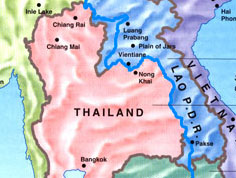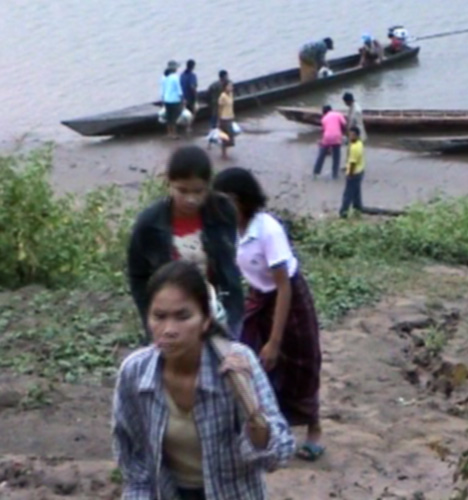Low Cost Technologies for Semi-literate Mekong Girls
The Low-cost Technology for Semi-literate Mekong Girls intiative is a core-funded dot-EDU pilot activity
May 2004
Laos and Thailand
This pilot project is designed to gauge the success of applying a versatile video compact disc (VCD) technology to meet critical learning needs of young girls who cross the Mekong in search of a more exciting and financially rewarding life in Thailand.

Map of Thailand and Laos, on either side of the Mekong River.
Media Portrayals and Harsh Realities
Young girls all around the Mekong region are drawn to cross over
into Thailand by media images of safe, healthy and well-dressed youth with
ample money in their pockets, enjoying a comfortable and exciting life.
When the young girls first cross the Mekong, they do not envision sacrificing
their health or safety but instead hope to achieve the same financial and
social gains they see Thai youth enjoying in the media. What they don’t
see is the high percentage of illegal migrants who are unable to survive
on the few baht (local currency) they take home from work. These people
are often exploited by unscrupulous employers, denied health services, and
have little opportunity to further their education. This reality creeps
up slowly, little by little, somewhere between home in a village in Laos
and life on the street in Bangkok.
The illusion of a better life in Bangkok may begin with visiting relatives
and perhaps making brooms to be sold across the river. The next step may
involve day passes to cross the river in hopes of selling the brooms at
the big Saturday market. Some girls then choose to stay on the Thai side
to work in a kiosk or assist a vendor. They enjoy the opportunity to socialize
with Thai youth as well as friends from Laos. However, once the girls have
been lured across the river, other offers begin to come along, such as work
in a larger town a bit further inland. The further inland the girls move,
the more alienated they become and the less familiar they and their families
are with potential employers. As a result, their risk of sexual exploitation,
exposure to HIV/AIDS and drug abuse, and falling victim to forced labor
is greatly increased. The beguiling truth is that their security subtly
lessens and the fated steps toward an unacceptable level of risk are often
too difficult to identify.

Contemplating a New life on the Thai side of the river.
VCD Modules Promote Learning and Reflection for Migrant Girls
In an effort to reach these girls before they find themselves in
compromising situations, this pilot seeks to demonstrate how VCD technology--already
very popular in the region-- can be harnessed to meet critical learning
needs among young girls crossing the Mekong River into Thailand, as well
as other groups of at-risk youth. Instructional design fully exploits the
VCD technology, distributing and reinforcing the learning through music,
dialogue, sequences of images, and subtitles. Due to the variety of spoken
languages in the region, the multiple sound tracks available are used strategically
to offer more than one language choice for both users and peer facilitators.
Communicative power is strengthened by maximizing the functional load of
the visual and oral media and limiting the role of print to simple and key
phrases.
The two model VCDs in development each contain 6 short modules and make
use of the medium’s reputation as a mode of entertainment as it opens
with well-known music from local artists. Each 8 minute module contains
a mini-drama or interview, a narrated news byte, and a telling sequence
of images that ends in an open-ended trigger question to stimulate reflection
and discussion. Content is organized to help migrant girls reflect on the
trade-offs between options and, as a result, to help them make more informed
choices. The full set of modules on a given VCD is displayed via a menu
of images on an opening screen, giving peer group facilitators, or girls
privately viewing the VCD, the option of following their interests and selecting
topics as often and in whatever sequence they desire.
To deliver “edu-tainment” style content, learners will use a
balanced combination of visual and print symbol, to access information in
areas of particular interest including 1) the various kinds of immigration
status and the differences between them, 2) how to get out from under oppressive
employers, 3) what kind of alternative health services are available under
the various kinds of legal and illegal immigrant status’, and 4) what
kinds of genuine employment options are available to immigrant girls who
are being taken advantage of by unscrupulous employers.
To make this pilot activity a success, EDC has partnered with two national NGOs (non-governmental organizations) to produce these VCDs. The Pattanarak Foundation has experience in working with girls at risk on the Thai side of the Mekong, while another partner, PADETC, is experienced in working with girls at risk on the Lao side of the border. Both partners are part of a network of groups and agencies involved in supporting at-risk girls who cross the Mekong. This puts the NGOs in a good position to test their combined effectiveness to produce the VCDs and reach the girls already involved in their programs. Looking beyond the pilot phases of the activity, the low cost of hardware, software, and production processes make adaptation of this technology in context and scale an attractive option for all involved.
The broader objective of this activity is to demonstrate the communicative power and versatility of this technology for meeting a range of learning needs, particularly among the teenagers and youth who are so attracted to the VCD for its entertainment value. Yet VCD technology can just as easily be harnessed to support classroom learning, particularly since the multiple sound tracks can be dedicated to training the teacher or facilitator or to provide them with guidance at difficult points in the process.
This is a core-funded dot-EDU pilot activity from January 1, 2004 until April 30, 2004 (dot-EDU Leader Award No: GDG-A-00-01-00011-00).
For more information, please contact:
Steve Anzalone, Asia Center Director, sanzalone@edc.org
